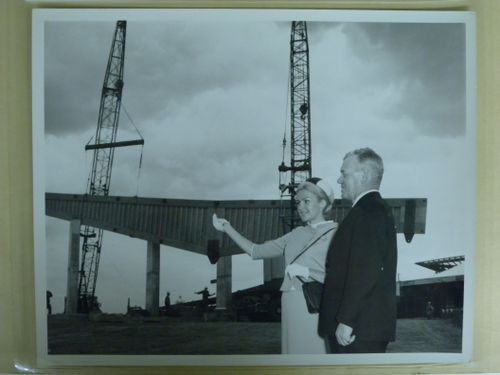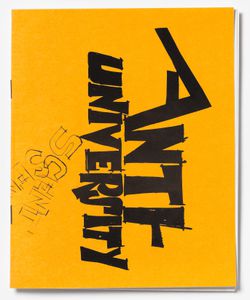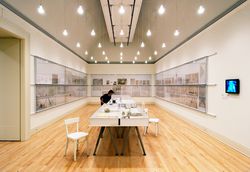ARCH255761
Description:
"Rear Admiral Hugh F. Pullen (Ret'd), general manager of the Atlantic Pavilion, watchesas the first of six 140-foot wooden beams is swung into place to start construction at the pavilion."--Description # 2 retrieved from ARCH260258.
1965-1966
Portrait of Rear Admiral Hugh F. Pullen and of an unidentified woman with the Atlantic Provinces' Pavilion under construction as background, Expo 67, Montréal, Québec
Actions:
ARCH255761
Description:
"Rear Admiral Hugh F. Pullen (Ret'd), general manager of the Atlantic Pavilion, watchesas the first of six 140-foot wooden beams is swung into place to start construction at the pavilion."--Description # 2 retrieved from ARCH260258.
Série(s)
Wenzel Hablik
AP162.S3
Description:
Series documents the contribution of architect Wenzel Hablik to the correspondence circle of Die gläserne Kette. Hablik participated using the pseudonym W.H.. Born in Brüx, Germany, (now Most, in Czech Republic) in 1881, Hablik worked as a porcelina painter from 1895 to 1897 and later as architectural draftsman. Between 1897 to 1902 he studied architecture at the Faschsdule für Tonindustrie und verwandte Gewerbe in Teplitz-Schönau, and at the Kungstgewerbeschule in Vienna in 1902. Between 1905 and 1906, he studied painting at the Akademie für bildenbe Künste in Prague. He worked in Itzehoe, Germany, after an invitation by a patron, Richard Biel, in 1907, where he start collaborating on textile designs with Elisabeth Lindemann, who he married in 1917. His work was exhibited at the Austellung für unbekannte Architeckten in 1919. The same year he joined the Arbeitsrat für Kunst lead by Bruno Taut. In 1925, Hablik published "Zyklus Architektur" an artist folio presenting some of his etched architectural fantasies. He worked for the family workshop by designing textiles and wall hangings. He died in 1934 in Itzehoe. (Source: Ian Boyd Whyte, Bruno Taut and the Architecture of Activism. Cambridge: Cambridge University Press, 1982) The series comprises letters and a drawing by Wenzel Hablik.
circa 1919-1920
Wenzel Hablik
Actions:
AP162.S3
Description:
Series documents the contribution of architect Wenzel Hablik to the correspondence circle of Die gläserne Kette. Hablik participated using the pseudonym W.H.. Born in Brüx, Germany, (now Most, in Czech Republic) in 1881, Hablik worked as a porcelina painter from 1895 to 1897 and later as architectural draftsman. Between 1897 to 1902 he studied architecture at the Faschsdule für Tonindustrie und verwandte Gewerbe in Teplitz-Schönau, and at the Kungstgewerbeschule in Vienna in 1902. Between 1905 and 1906, he studied painting at the Akademie für bildenbe Künste in Prague. He worked in Itzehoe, Germany, after an invitation by a patron, Richard Biel, in 1907, where he start collaborating on textile designs with Elisabeth Lindemann, who he married in 1917. His work was exhibited at the Austellung für unbekannte Architeckten in 1919. The same year he joined the Arbeitsrat für Kunst lead by Bruno Taut. In 1925, Hablik published "Zyklus Architektur" an artist folio presenting some of his etched architectural fantasies. He worked for the family workshop by designing textiles and wall hangings. He died in 1934 in Itzehoe. (Source: Ian Boyd Whyte, Bruno Taut and the Architecture of Activism. Cambridge: Cambridge University Press, 1982) The series comprises letters and a drawing by Wenzel Hablik.
series
circa 1919-1920
archives
Niveau de description archivistique:
Fonds
CP138
Résumé:
The Gordon Matta-Clark collection documents the personal and professional activities of Gordon Matta-Clark through his correspondence, texts, library, artwork and films, created predominantly between 1969 and 1978. Additionally the collection contains correspondence and photographs collected by Anne Alpert, Matta-Clark's mother, and documentation on his work collected by his widow Jane Crawford following his death.
1914-2008
Collection Gordon Matta-Clark
Actions:
CP138
Résumé:
The Gordon Matta-Clark collection documents the personal and professional activities of Gordon Matta-Clark through his correspondence, texts, library, artwork and films, created predominantly between 1969 and 1978. Additionally the collection contains correspondence and photographs collected by Anne Alpert, Matta-Clark's mother, and documentation on his work collected by his widow Jane Crawford following his death.
archives
Niveau de description archivistique:
Collection
1914-2008
archives
Niveau de description archivistique:
Collection
AP162
Résumé:
The Die gläserne Kette CCA Collection documents the chain of correspondence exchanged between German architects Hermann Finsterlin, Paul Goesch, Wenzel Hablik, Hans Hansen, Carl Krayl, Hans and Wassili Luckhardt, Hans Scharoun, and Bruno and Max Taut between 1919 and 1920 on the subject of utopian architecture and society. This CCA collection features original copies and reproductions of the correspondence, as well as a limited number of drawings by the members of the group.
1911-1977
Collection Die gläserne Kette
Actions:
AP162
Résumé:
The Die gläserne Kette CCA Collection documents the chain of correspondence exchanged between German architects Hermann Finsterlin, Paul Goesch, Wenzel Hablik, Hans Hansen, Carl Krayl, Hans and Wassili Luckhardt, Hans Scharoun, and Bruno and Max Taut between 1919 and 1920 on the subject of utopian architecture and society. This CCA collection features original copies and reproductions of the correspondence, as well as a limited number of drawings by the members of the group.
archives
Niveau de description archivistique:
Collection AP162
1911-1977
De 1966 à 1968, Shadrach Woods et Cedric Price, tous deux architectes et professeurs à Paris et à Londres, ont été happés par un tourbillon de changements au sein du monde de l’éducation. Comme l’architecture, le domaine était en quête de nouveaux modèles; les théoriciens cherchaient à reformuler les problèmes de base de l’éducation, plutôt que de simplement proposer de(...)
Maison Shaughnessy Mot(s)-clé(s):
Shadrach Woods, Cedric Price, chercheure en résidence, Federica Doglio
24 juillet 2014, 18h
Séminaire de chercheur en résidence : Federica Doglio
Actions:
Description:
De 1966 à 1968, Shadrach Woods et Cedric Price, tous deux architectes et professeurs à Paris et à Londres, ont été happés par un tourbillon de changements au sein du monde de l’éducation. Comme l’architecture, le domaine était en quête de nouveaux modèles; les théoriciens cherchaient à reformuler les problèmes de base de l’éducation, plutôt que de simplement proposer de(...)
Maison Shaughnessy Mot(s)-clé(s):
Shadrach Woods, Cedric Price, chercheure en résidence, Federica Doglio
Antoine Picon, chercheur principal et boursier Mellon, soutient que le design doit, afin d’apporter une contribution utile à la construction de villes intelligentes, s’appuyer sur la nature changeante de l’expérience et du sujet urbains.
1 mai 2014
Antoine Picon : « Smart Cities: A New Challenge for Design »
Actions:
Description:
Antoine Picon, chercheur principal et boursier Mellon, soutient que le design doit, afin d’apporter une contribution utile à la construction de villes intelligentes, s’appuyer sur la nature changeante de l’expérience et du sujet urbains.
Série(s)
Architectural projects
AP056.S1
Description:
The Architectural Projects series, 1984-2003, records 125 architectural projects from Canada, the United States, Germany and Switzerland. These projects include university buildings and campuses, public spaces, civic buildings, offices, interior and industrial design, residences, museums, theatres and concert halls, a winery, and retail stores. The projects include built work, proposals and competition entries. Projects were identified and separated based on distinct project numbers assigned by the creating office, along with the project dates and titles when further clarification was necessary. The project numbering scheme used by the office was not consistent, but most of the numbers are four digits and begin with last two digits of the project start year. These projects are recorded primarily through drawings, but some photographs, paintings, textual records, periodicals, and models are also included in this series. The majority of drawings for each project are originals and a large part of reprographic copies have annotations. The drawings for each project typically consist of surveys, sketches, plans, sections, elevations, axonometric drawings, details, perspectives, and drawings issued for construction. Some of the drawings are mounted for presentation purposes. A large number of furnishing drawings are also included for interior design projects. Photographs in this series show finished work completed by the firm, the project models, and reproductions of drawings and paintings. The paintings in this series are mostly watercolours used for presentation. The textual records are very sparse in this series and consist of rough notes used to supplement drawings. The periodicals are magazines that highlight the completed projects. The amount of materials for each project vary greatly, with built projects having the most complete records and project proposals having the least.
1984-2003
Architectural projects
Actions:
AP056.S1
Description:
The Architectural Projects series, 1984-2003, records 125 architectural projects from Canada, the United States, Germany and Switzerland. These projects include university buildings and campuses, public spaces, civic buildings, offices, interior and industrial design, residences, museums, theatres and concert halls, a winery, and retail stores. The projects include built work, proposals and competition entries. Projects were identified and separated based on distinct project numbers assigned by the creating office, along with the project dates and titles when further clarification was necessary. The project numbering scheme used by the office was not consistent, but most of the numbers are four digits and begin with last two digits of the project start year. These projects are recorded primarily through drawings, but some photographs, paintings, textual records, periodicals, and models are also included in this series. The majority of drawings for each project are originals and a large part of reprographic copies have annotations. The drawings for each project typically consist of surveys, sketches, plans, sections, elevations, axonometric drawings, details, perspectives, and drawings issued for construction. Some of the drawings are mounted for presentation purposes. A large number of furnishing drawings are also included for interior design projects. Photographs in this series show finished work completed by the firm, the project models, and reproductions of drawings and paintings. The paintings in this series are mostly watercolours used for presentation. The textual records are very sparse in this series and consist of rough notes used to supplement drawings. The periodicals are magazines that highlight the completed projects. The amount of materials for each project vary greatly, with built projects having the most complete records and project proposals having the least.
Series
1984-2003
Projet
AP018.S1.1969.PR01
Description:
This project series documents the expansion of the Art Gallery of Ontario (AGO) in Toronto from 1969-1974. The office identified the project as number 69006. This project consisted of the vast expansion of the AGO that began in 1969, which largely came about due to a multi-million dollar donation from English sculpture Henry Moore. Most prominent in this project was the design and construction of the Henry Moore Sculpture Centre, a new gallery to house the extensive artworks of Henry Moore in the AGO’s collection. This included $15 million’s worth of art that Moore donated at the start of the project. The project was made up of two phases. The first included construction of the Henry Moore Sculpture Centre, the Sam and Ayala Zacks Wing, a link to the pre-existing Grange mansion, and updates to the art gallery’s finishes. The second phase proposed additional updates to existing finishes. By the end of this project, the architects had also added a public lounge, dining room and cafeteria, a members’ lounge, lecture areas (including the Henry Moore Lecture Hall), classrooms, and spaces for the gallery’s special services. The work was further divided into 4 physical areas of the art gallery (A, B, C and D) and the drawings for this project reflect this division. Before this work had been completed, a “Stage II” to the expansion had already been approved by the owners (Stage II is also included in this fonds, see AP018.S1.1972.PR08). In the documentation, this project was originally called the Henry Moore Sculpture Centre, Art Gallery of Ontario, Expansion Phases 1 and 2. However, as multiple stages to the expansion developed later on, this project eventually became known as the Stage I Expansion. While the project contract was originally given to John B. Parkin Associates, John C. Parkin continued the project under his new firm, Parkin Architects Planners, after parting ways with partner John B. Parkin in 1971. The project is recorded through drawings, textual records, and mounted photographs dating from 1968-1986. There are numerous original drawings showing the design development of the new galleries. Two presentation boards show photographs of the project model. The textual records consist of correspondence with contractors and clients, inspection and other site reports, specifications, contract data, consultancy records, schedules, change orders, financial documentation, conference reports, area calculations, research materials, detail planning records, and project notebooks. Box AP018.S1.1969.PR01.007 contains an index to the textual records, which was created by the office. This project series also contains one box of textual documentation that spans across multiple project series related to the AGO expansion within this fonds (see AP018.S1.1969.PR01.044). This includes press releases, newspaper articles, project proposals and studies, correspondence with Henry Moore, meeting minutes and reports.
1968-1986
Henry Moore Sculpture Centre, Art Gallery of Ontario, Stage I Expansion, Toronto (1969-1974)
Actions:
AP018.S1.1969.PR01
Description:
This project series documents the expansion of the Art Gallery of Ontario (AGO) in Toronto from 1969-1974. The office identified the project as number 69006. This project consisted of the vast expansion of the AGO that began in 1969, which largely came about due to a multi-million dollar donation from English sculpture Henry Moore. Most prominent in this project was the design and construction of the Henry Moore Sculpture Centre, a new gallery to house the extensive artworks of Henry Moore in the AGO’s collection. This included $15 million’s worth of art that Moore donated at the start of the project. The project was made up of two phases. The first included construction of the Henry Moore Sculpture Centre, the Sam and Ayala Zacks Wing, a link to the pre-existing Grange mansion, and updates to the art gallery’s finishes. The second phase proposed additional updates to existing finishes. By the end of this project, the architects had also added a public lounge, dining room and cafeteria, a members’ lounge, lecture areas (including the Henry Moore Lecture Hall), classrooms, and spaces for the gallery’s special services. The work was further divided into 4 physical areas of the art gallery (A, B, C and D) and the drawings for this project reflect this division. Before this work had been completed, a “Stage II” to the expansion had already been approved by the owners (Stage II is also included in this fonds, see AP018.S1.1972.PR08). In the documentation, this project was originally called the Henry Moore Sculpture Centre, Art Gallery of Ontario, Expansion Phases 1 and 2. However, as multiple stages to the expansion developed later on, this project eventually became known as the Stage I Expansion. While the project contract was originally given to John B. Parkin Associates, John C. Parkin continued the project under his new firm, Parkin Architects Planners, after parting ways with partner John B. Parkin in 1971. The project is recorded through drawings, textual records, and mounted photographs dating from 1968-1986. There are numerous original drawings showing the design development of the new galleries. Two presentation boards show photographs of the project model. The textual records consist of correspondence with contractors and clients, inspection and other site reports, specifications, contract data, consultancy records, schedules, change orders, financial documentation, conference reports, area calculations, research materials, detail planning records, and project notebooks. Box AP018.S1.1969.PR01.007 contains an index to the textual records, which was created by the office. This project series also contains one box of textual documentation that spans across multiple project series related to the AGO expansion within this fonds (see AP018.S1.1969.PR01.044). This includes press releases, newspaper articles, project proposals and studies, correspondence with Henry Moore, meeting minutes and reports.
Project
1968-1986
pages web
Making Mamak est une boîte à outils destinée à tous les travailleurs culturels, organisateurs sociaux et membres de la communauté. Cette boîte à outils est conçue pour aider à s’engager dans des formes locales et communautaires de création et de rassemblement. En s’inspirant des collectifs artistiques des centres urbains de Malaisie, il est possible de développer des liens de parenté avec sa propre communauté, de formuler des aides mutuelles, de s’approprier des espaces collectifs et de lancer des mouvements sociaux de fond.
« Making Mamak » : Écologies collectives de l’espace urbain
Actions:
Résumé:
Making Mamak est une boîte à outils destinée à tous les travailleurs culturels, organisateurs sociaux et membres de la communauté. Cette boîte à outils est conçue pour aider à s’engager dans des formes locales et communautaires de création et de rassemblement. En s’inspirant des collectifs artistiques des centres urbains de Malaisie, il est possible de développer des liens de parenté avec sa propre communauté, de formuler des aides mutuelles, de s’approprier des espaces collectifs et de lancer des mouvements sociaux de fond.
pages web
À partir d’hypothèses et de points de vue différents, Cedric Price, Aldo Rossi, James Stirling et Gordon Matta-Clark se sont engagés dans un processus de reformulation radicale du statut, de l’histoire et du rôle de l’architecture. sortis du cadre: price rossi stirling + matta-clark fait entrer en dialogue les réflexions de quatre figures marquantes des années 1970 à(...)
Salles principales
23 octobre 2003 au 6 septembre 2004
sortis du cadre : price rossi stirling + matta-clark
Actions:
Description:
À partir d’hypothèses et de points de vue différents, Cedric Price, Aldo Rossi, James Stirling et Gordon Matta-Clark se sont engagés dans un processus de reformulation radicale du statut, de l’histoire et du rôle de l’architecture. sortis du cadre: price rossi stirling + matta-clark fait entrer en dialogue les réflexions de quatre figures marquantes des années 1970 à(...)
Salles principales


